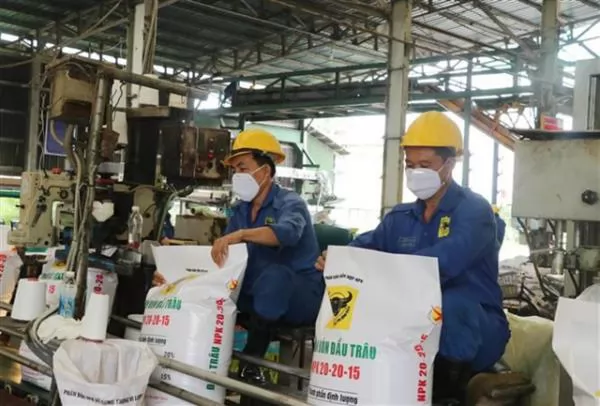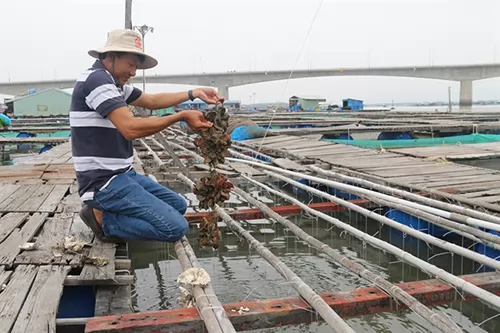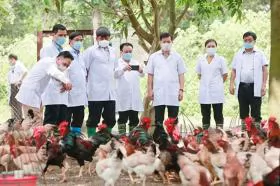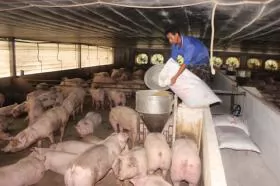Farm profits threatened by soaring fertiliser prices

Workers packaging fertilisers at a factory in Long An Province. Ballooning fertiliser prices have been driving up farming costs, worrying many farmers. Photo vietnamplus.vn
HÀ NỘI — Fertiliser prices have been skyrocketing since last year, crippling many farmers.
Trần Linh, a farmer in Đắk Lắk Province, was concerned that rising fertiliser prices would render all his agricultural efforts wasted.
Normally, he spends VNĐ2 million (US$87.6) for each sào (unit of area) of his paddy fields, not including labour costs, to earn VNĐ7 million ($306.6) per sào.
This year, due to higher fertiliser prices and low rice prices, the costs rose to VNĐ3 million per sào while the revenues fell to VNĐ5 million per sào, dragging down his profits.
“It’s difficult to make ends meet with such meagre income,” said the rice farmer.
Hà Trang, a farm owner in Lâm Đồng Province, was also worried about the high cost of fertilising the soil.
She said that soil nutrition materials doubled in price in just one year.
If left unchecked, the rise in fertiliser prices, coupled with high petroleum prices and high labour costs, would strip away all her farming profits.
“NPK fertiliser stayed at around VNĐ800,000 per bag last year. Now, it is twice the price, at VNĐ1.5-1.7 million per bag. I’m going to suffer losses soon,” said the coffee farm owner.
Not only rice and coffee farmers are being hard-hit by high fertiliser prices, but also dragon fruit farmers.
Dragon fruit farmers have been selling their produce at a loss since China tightened its COVID-19 preventive measures.
Now, mounting fertiliser bills are adding to their woes.
Many dragon fruit farmers in Bình Thuận Province said that they were likely to go bankrupt if the situation did not improve.
“Dragon fruits have been sold at a dirt-cheap price for two years. Meanwhile, fertiliser prices have been increasing multifold. It seems certain that dragon fruit farmers will become heavily indebted after this season,” said farmer Nguyễn Thị Sen.
Parts of fertiliser used in Việt Nam are imports so its fertiliser prices normally move in line with the world market’s prices.
The recent drop in global supply has been pushing up the material prices worldwide, sending domestic prices through the roof.
China, one of the largest fertiliser suppliers in the world, imposed export restrictions on 29 types of fertiliser in mid-October last year.
Russia followed suit in November by announcing six-month quotas on its nitro-derived fertiliser exports.
Western countries fuelled the situation by imposing sanctions against Belarus, a country that accounts for one-fifth of global potash supply. Potash is a key ingredient in potash-derived fertiliser.
It is also worth mentioning that some European fertiliser plants had to halt or curtail production owing to ballooning natural gas costs, further tightening the market.
Yara, the largest fertiliser producer in Europe, said in mid-September that it would reduce fertiliser output of its factories by 40 per cent on grounds of surging costs.
German chemical giant BASF did likewise later by cutting production in Antwerp and Ludwigshafen.
Vietnamese fertiliser importer and supplier Vinacam forecasted that DAP fertiliser prices would continue to rise until China gets its exports back to normal.
Regarding MOP standard fertiliser and NPK 16-16-18 fertiliser, their prices are expected to remain stable due to abundant reserves.
Meanwhile, MOP granular fertiliser is forecast to continue to go up in price, staying at around VNĐ17-18 million per tonne in March 2022.
In contrast, urea fertiliser prices are projected to fall slightly and are unlikely to bounce back, even in the main rice-growing season.
In response to the continuously soaring prices, the Ministry of Agriculture and Rural Development has issued Directive No.653, urging authorities to instruct farmers how to efficiently use fertiliser to reduce farming costs.
Farmers have been called on to replace inorganic fertiliser with that made from domestic waste and compost, and organic fertiliser to cut costs further.
The ministry also suggested the widespread adoption of various advanced farming techniques to boost productivity and reduce fertiliser usage, including the System of Rice Intensification and organic farming.
According to the General Department of Customs, Việt Nam imported around 322,700 tonnes of fertiliser in January 2022 with an average price of $476 per tonne.
Fertiliser products from China accounted for 42.6 per cent of total fertiliser imports, staying at 137,430 tonnes.
Russian fertiliser came next with 53,773 tonnes (19.3 per cent) and was followed by Belarusian fertiliser with 30,815 tonnes. — VNS
Maybe you are interested

Agricultural innovation key to capital's food security
HÀ NỘI — High-value specialty crops and livestock are being developed to meet the increasing consumption needs of domestic consumers, in line with the comparative advantage of each locality, but more needs to be done, Deputy Minister of Agriculture and Ru

Bà Rịa – Vũng Tàu farmers breed Pacific oysters
Viet Nam News / BÀ RỊA-VŨNG TÀU — Many farmers in the southern province of Bà Rịa – Vũng Tàu are breeding Pacific oysters since they have a high survival rate and steady demand in the market.

A swine of the times - pig production down in An Giang Province
AN GIANG — Pig breeders in the southern province of An Giang are struggling to deal with the combined impacts of the COVID-19 pandemic, diseases in herds and falling pig prices.





